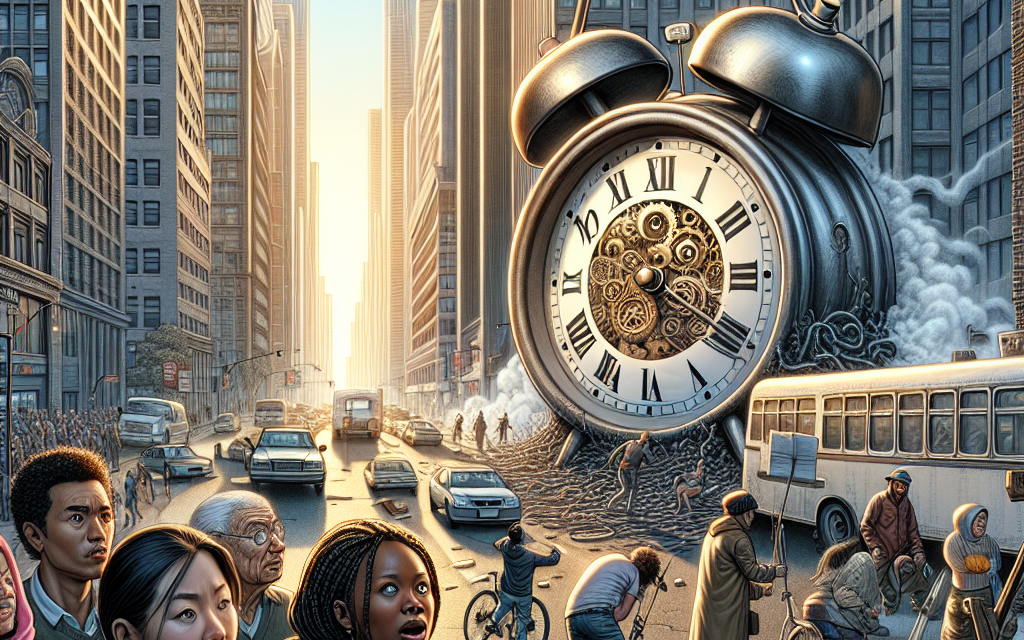“Friday Recap: Your Weekly Wake-Up Call from the Streets.”
Introduction
“Friday Recap: A Wake-Up Call from the Streets” serves as a powerful reminder of the realities faced by communities often overlooked. This weekly summary highlights key events, grassroots movements, and urgent issues that resonate within urban environments. By amplifying voices from the streets, it aims to foster awareness and inspire action, urging readers to confront the challenges and triumphs that shape our society. Through insightful analysis and compelling narratives, this recap not only informs but also calls for a collective response to the pressing matters at hand.
Friday Recap: Key Takeaways from the Streets
As the week draws to a close, the streets have once again served as a vibrant canvas reflecting the pulse of society. This Friday, the events that unfolded provided critical insights into the prevailing sentiments and challenges faced by communities. Observers noted a palpable sense of urgency among the participants, who gathered to voice their concerns and aspirations. The demonstrations, while diverse in their specific issues, shared a common thread: a call for accountability and change.
One of the most striking aspects of the day was the sheer number of individuals who took to the streets. This turnout was not merely a reflection of the issues at hand but also an indication of a growing collective consciousness. People from various backgrounds united, demonstrating that the desire for social justice transcends demographic boundaries. This convergence of voices underscored the importance of solidarity in the face of adversity, highlighting that change is often born from collaboration and shared purpose.
Moreover, the themes that emerged from the demonstrations were both poignant and pressing. Many participants articulated their frustrations regarding systemic inequalities, particularly in areas such as education, healthcare, and housing. These issues, which have long been simmering beneath the surface, were brought to the forefront, demanding immediate attention from policymakers. The urgency of these concerns was palpable, as speakers emphasized the need for tangible solutions rather than empty promises. This insistence on accountability served as a wake-up call, reminding those in power that the status quo is no longer acceptable.
In addition to the calls for reform, the demonstrations also highlighted the role of grassroots organizations in mobilizing communities. These groups have been instrumental in fostering dialogue and providing resources for those affected by social injustices. Their efforts not only amplify the voices of the marginalized but also empower individuals to take action. As the day progressed, it became evident that these organizations are vital in bridging the gap between communities and decision-makers, ensuring that the needs of the people are not overlooked.
Furthermore, the media coverage of the events played a crucial role in shaping public perception. As news outlets reported on the demonstrations, they brought attention to the issues at stake, thereby amplifying the message of the participants. However, it is essential to approach this coverage critically, as the framing of these events can significantly influence how they are perceived by the broader public. Responsible journalism that accurately represents the voices of those involved is paramount in fostering understanding and empathy.
As the sun set on Friday, the streets echoed with the sentiments of hope and determination. While the challenges ahead are formidable, the collective action witnessed throughout the day serves as a reminder that change is possible. The key takeaways from this Friday’s events extend beyond the immediate issues; they encompass a broader call for engagement and participation in the democratic process. It is a reminder that every voice matters and that sustained advocacy is essential for meaningful progress.
In conclusion, the events of this Friday were not merely a series of protests; they were a powerful demonstration of the community’s resolve to confront injustice. As we reflect on these key takeaways, it becomes clear that the streets have once again provided a vital platform for dialogue and action. The wake-up call from the streets is not just a moment in time; it is an ongoing movement that demands our attention and commitment to fostering a more equitable society.
Lessons Learned: Insights from Urban Experiences
In the ever-evolving landscape of urban life, the streets serve as a dynamic classroom, offering invaluable lessons that extend beyond traditional educational settings. As cities continue to grow and diversify, the experiences encountered within their confines provide profound insights into societal structures, human behavior, and the complexities of community dynamics. This week’s recap highlights the essential lessons learned from urban experiences, emphasizing the importance of understanding the multifaceted nature of city life.
One of the most significant insights gleaned from urban experiences is the necessity of adaptability. The fast-paced environment of the city often requires individuals to navigate a myriad of challenges, from fluctuating economic conditions to shifting social norms. For instance, street vendors exemplify this adaptability; they must constantly adjust their offerings and strategies to meet the demands of an ever-changing clientele. This ability to pivot in response to external pressures is a crucial skill that can be applied in various aspects of life, including personal and professional realms.
Moreover, urban experiences underscore the importance of community engagement. Cities are melting pots of cultures, ideas, and perspectives, and the interactions that occur within these spaces can foster a sense of belonging and solidarity. Community initiatives, such as neighborhood clean-up days or local art projects, illustrate how collective action can lead to positive change. These experiences highlight the power of collaboration and the impact that individuals can have when they come together for a common cause. Engaging with one’s community not only strengthens social ties but also cultivates a deeper understanding of the diverse narratives that shape urban life.
In addition to adaptability and community engagement, urban experiences also reveal the significance of resilience. The streets often reflect the struggles and triumphs of their inhabitants, showcasing stories of perseverance in the face of adversity. For example, individuals experiencing homelessness navigate a complex web of challenges daily, yet many demonstrate remarkable resilience as they seek stability and support. Their experiences serve as a poignant reminder of the human spirit’s capacity to endure and thrive, even in the most difficult circumstances. This resilience is not only inspiring but also serves as a call to action for society to address systemic issues that contribute to such hardships.
Furthermore, the lessons learned from urban experiences extend to the realm of social justice. The streets are often the backdrop for movements advocating for equality and change, highlighting the urgent need for awareness and action regarding social issues. Protests and demonstrations serve as powerful reminders of the collective voice that can emerge from urban spaces, urging individuals to reflect on their roles within the larger societal framework. Engaging with these movements fosters a deeper understanding of the complexities surrounding issues such as racial inequality, economic disparity, and environmental justice.
In conclusion, the insights gained from urban experiences are both profound and multifaceted. They emphasize the importance of adaptability, community engagement, resilience, and social justice. As individuals navigate the complexities of city life, these lessons serve as guiding principles that can enhance personal growth and foster a more inclusive society. Ultimately, the streets act as a mirror reflecting the diverse experiences of their inhabitants, offering a wake-up call to recognize the interconnectedness of our lives and the shared responsibility we hold in shaping our communities.
Community Voices: What the Streets Are Saying
In recent weeks, the streets have become a vibrant tapestry of voices, each thread woven with the experiences, hopes, and frustrations of the community. As we reflect on the events of Friday, it is essential to recognize the significance of these voices and the messages they convey. The streets have served as a platform for individuals to express their concerns, aspirations, and calls for change, creating a collective narrative that cannot be ignored.
One of the most prominent themes emerging from these discussions is the urgent need for social justice. Many community members have taken to the streets to advocate for equitable treatment and systemic reform. Their passionate pleas highlight the disparities that persist within our society, particularly regarding race, economic status, and access to essential services. As these voices resonate through the urban landscape, they remind us that the fight for justice is not merely a political issue but a deeply personal one that affects the lives of countless individuals.
Moreover, the streets have become a space for dialogue about public safety and community well-being. Residents are increasingly vocal about their experiences with crime and the need for effective policing strategies that prioritize community engagement over punitive measures. This shift in perspective underscores a growing recognition that safety is not solely the absence of crime but the presence of trust and collaboration between law enforcement and the communities they serve. As conversations unfold, it becomes clear that a holistic approach to public safety is essential for fostering a sense of security and belonging.
In addition to these pressing issues, the streets are also echoing calls for economic revitalization. Many community members are advocating for policies that support local businesses and create job opportunities, particularly in underserved areas. The impact of economic inequality has been exacerbated by recent global events, and the need for sustainable development has never been more critical. As individuals share their stories of struggle and resilience, they emphasize the importance of investing in the community to build a brighter future for all.
Furthermore, environmental concerns have emerged as a significant topic of discussion among community members. The effects of climate change are increasingly felt in urban areas, prompting residents to demand action on sustainability and environmental justice. The streets are alive with conversations about green spaces, clean air, and the need for policies that prioritize the health of both people and the planet. This growing awareness reflects a broader understanding that environmental issues disproportionately affect marginalized communities, further emphasizing the interconnectedness of social and environmental justice.
As we consider the messages emanating from the streets, it is crucial to acknowledge the power of collective action. The unity displayed by community members serves as a reminder that change is possible when individuals come together to advocate for a common cause. The streets are not just a backdrop for protests; they are a living testament to the resilience and determination of those who seek to create a better world.
In conclusion, the voices rising from the streets serve as a wake-up call, urging us to listen and engage with the pressing issues facing our communities. From social justice to economic revitalization and environmental sustainability, these conversations are vital for shaping a future that reflects the values and aspirations of all individuals. As we move forward, it is imperative that we heed these calls and work collaboratively to address the challenges that lie ahead, ensuring that every voice is heard and valued in the ongoing pursuit of justice and equity.
The Impact of Street Culture on Weekend Plans
As the weekend approaches, the influence of street culture becomes increasingly palpable, shaping not only social interactions but also the very fabric of weekend plans for many individuals. This phenomenon is particularly evident in urban environments, where the vibrancy of street life serves as both a backdrop and a catalyst for various activities. The streets, often bustling with energy, provide a unique setting that encourages spontaneous gatherings, artistic expressions, and cultural exchanges, all of which significantly impact how people choose to spend their weekends.
One of the most notable aspects of street culture is its ability to foster community engagement. As individuals navigate through urban landscapes, they are often drawn to street performances, art installations, and local markets that reflect the diverse identities and stories of the community. These elements not only enhance the aesthetic appeal of the surroundings but also create opportunities for social interaction. Consequently, many people find themselves altering their weekend plans to include visits to these vibrant locales, seeking to immerse themselves in the rich tapestry of experiences that street culture offers.
Moreover, the influence of street culture extends beyond mere entertainment; it also plays a crucial role in shaping consumer behavior. Local businesses often thrive on the foot traffic generated by street events, leading to a symbiotic relationship between street culture and commerce. As individuals are exposed to various vendors and artisans, they are more likely to support local enterprises, thereby contributing to the economic vitality of their neighborhoods. This dynamic encourages weekend plans that prioritize local exploration, as individuals seek to discover hidden gems and support their community.
In addition to fostering community and stimulating local economies, street culture also serves as a platform for social commentary and activism. Many street artists and performers use their craft to address pressing social issues, prompting conversations that resonate with the public. As a result, weekend plans may be influenced by a desire to engage with these important dialogues, whether through attending a street art exhibition or participating in a community event aimed at raising awareness. This engagement not only enriches the weekend experience but also cultivates a sense of responsibility among individuals to contribute positively to their communities.
Furthermore, the impact of street culture on weekend plans is not limited to urban dwellers; it also attracts visitors from surrounding areas. Tourists often seek out authentic experiences that reflect the local culture, and street life provides a genuine glimpse into the heart of a city. Consequently, weekend itineraries frequently include visits to iconic street markets, food festivals, and cultural events, all of which highlight the unique character of the destination. This influx of visitors can further invigorate local economies and enhance the cultural landscape, creating a cycle of growth and engagement.
In conclusion, the influence of street culture on weekend plans is multifaceted, encompassing community engagement, economic stimulation, social activism, and tourism. As individuals navigate their weekends, they are increasingly drawn to the dynamic experiences that street life offers, leading to a greater appreciation for the cultural richness of their surroundings. This evolving relationship between street culture and weekend activities serves as a reminder of the importance of community connection and the power of shared experiences in shaping our social landscapes. Ultimately, as we reflect on our weekend choices, it becomes clear that the streets are not merely a backdrop but a vital component of our collective cultural identity.
Reflections on Urban Life: A Weekly Summary
In the ever-evolving landscape of urban life, each week presents a unique tapestry of experiences, challenges, and revelations that shape the collective consciousness of city dwellers. This past week served as a poignant reminder of the complexities inherent in urban existence, offering a wake-up call that reverberated through the streets and into the hearts of those who inhabit them. As we reflect on the events that unfolded, it becomes evident that the vibrancy of city life is often accompanied by a stark juxtaposition of beauty and struggle.
One of the most striking aspects of urban life is the palpable energy that permeates the streets. This week, the hustle and bustle of daily routines was punctuated by moments of solidarity and community engagement. Local markets thrived, showcasing the rich diversity of cultures that coexist within the city. Vendors proudly displayed their wares, while residents gathered to share stories and laughter, creating a sense of belonging amidst the chaos. Such interactions serve as a reminder that, despite the challenges faced, there exists a profound connection among individuals that transcends socioeconomic barriers.
However, this week also illuminated the pressing issues that continue to plague urban environments. Reports of rising homelessness and food insecurity painted a sobering picture of the realities many face daily. As we navigated the streets, it became increasingly clear that the struggles of our fellow citizens cannot be overlooked. The stark contrast between affluence and poverty was evident, prompting a collective introspection about our responsibilities as members of a shared community. This juxtaposition not only highlights the disparities that exist but also calls for a renewed commitment to social justice and equity.
Moreover, the week was marked by a series of protests advocating for systemic change. Citizens took to the streets, demanding action on issues ranging from climate change to police reform. These demonstrations served as a powerful reminder of the role that civic engagement plays in shaping urban life. The voices of the people echoed through the city, urging policymakers to listen and respond to the needs of their constituents. In this context, the streets became a canvas for expression, illustrating the resilience and determination of those who refuse to remain silent in the face of adversity.
As we reflect on these events, it is essential to recognize the importance of dialogue and collaboration in addressing the challenges that urban life presents. Community organizations and local leaders are increasingly stepping up to bridge gaps and foster understanding among diverse populations. Initiatives aimed at providing resources and support to marginalized groups are gaining momentum, highlighting the potential for positive change when individuals come together with a shared purpose. This week’s events serve as a reminder that while the road ahead may be fraught with obstacles, collective action can pave the way for a more equitable future.
In conclusion, the past week has been a microcosm of urban life, encapsulating both the vibrancy and the struggles that define our cities. As we move forward, it is crucial to carry these reflections with us, allowing them to inform our actions and interactions within our communities. The wake-up call from the streets urges us to remain vigilant, compassionate, and proactive in our efforts to create a more inclusive and just urban environment. By embracing the complexities of city life, we can foster a sense of unity that transcends individual experiences, ultimately enriching the fabric of our shared existence.
Street Stories: Highlighting Local Heroes
In the heart of urban landscapes, where the hustle and bustle of daily life often overshadows individual narratives, local heroes emerge from the shadows, illuminating the resilience and compassion that define communities. These unsung champions, often overlooked, play pivotal roles in shaping the social fabric of their neighborhoods. Their stories serve as a reminder of the profound impact that one person can have on the lives of many, and this week, we take a moment to highlight some of these remarkable individuals.
One such hero is Maria, a dedicated community organizer who has spent the last decade working tirelessly to improve access to education for underprivileged children in her neighborhood. Maria’s journey began when she noticed the stark disparities in educational resources available to children in her community compared to those in more affluent areas. Fueled by a desire to create change, she founded a local tutoring program that not only provides academic support but also fosters a sense of belonging among the children. Through her efforts, Maria has transformed the lives of countless students, empowering them to pursue their dreams and break the cycle of poverty.
Transitioning from education to health, we encounter James, a former paramedic who now runs a mobile health clinic for the homeless population in the city. After witnessing the struggles of individuals without access to basic healthcare, James decided to take action. He mobilized a team of volunteers and secured funding to create a clinic that travels to various locations, providing essential medical services and resources. His commitment to serving those in need has not only improved health outcomes but has also instilled a sense of dignity and hope among the individuals he serves. James’s story exemplifies how one person’s initiative can address systemic issues and foster a healthier community.
As we delve deeper into the streets, we meet Aisha, a local artist who uses her talent to advocate for social justice. Through her vibrant murals, Aisha tells the stories of marginalized communities, giving voice to those often silenced. Her artwork not only beautifies the urban landscape but also sparks conversations about important social issues, encouraging community members to engage in dialogue and action. Aisha’s creative approach to activism highlights the power of art as a tool for change, reminding us that creativity can be a catalyst for social awareness and transformation.
Moreover, we cannot overlook the contributions of local business owners who have stepped up during challenging times. Take, for instance, the story of the Patel family, who own a small grocery store in a neighborhood hit hard by economic downturns. During the pandemic, they implemented a pay-what-you-can model, ensuring that everyone had access to essential food items, regardless of their financial situation. Their selfless actions not only provided sustenance but also fostered a sense of community solidarity, demonstrating that compassion can thrive even in the most trying circumstances.
In conclusion, the stories of these local heroes serve as a powerful reminder of the strength and resilience found within our communities. Each individual, through their unique contributions, plays a vital role in addressing the challenges faced by their neighbors. As we reflect on these narratives, it becomes clear that the true essence of community lies in the collective efforts of those who dare to make a difference. Their unwavering commitment to service inspires us all to recognize the potential for change that exists within each of us, urging us to take action in our own neighborhoods.
Preparing for the Weekend: Street-Inspired Motivation
As the week draws to a close, the streets come alive with a unique energy that serves as a powerful reminder of the resilience and creativity found within urban environments. This Friday, as we prepare for the weekend, it is essential to reflect on the lessons and motivations that can be gleaned from the vibrant tapestry of street culture. The streets, often seen as mere thoroughfares, are in fact dynamic spaces that encapsulate the spirit of community, innovation, and determination.
In many cities, street art has emerged as a prominent form of expression, transforming blank walls into canvases that tell stories of struggle, hope, and identity. Artists utilize their surroundings to communicate messages that resonate with the public, often addressing social issues and inspiring change. This artistic movement not only beautifies urban landscapes but also serves as a wake-up call, urging individuals to engage with their communities and reflect on the challenges faced by those around them. As we head into the weekend, it is crucial to consider how these messages can motivate us to take action, whether through volunteering, supporting local businesses, or simply engaging in meaningful conversations with our neighbors.
Moreover, the hustle and bustle of street life exemplifies the tenacity required to navigate the complexities of modern existence. Street vendors, performers, and entrepreneurs embody a spirit of perseverance that can inspire us all. Their ability to adapt and thrive in challenging circumstances serves as a reminder that success often comes from hard work and determination. As we prepare for our own weekend endeavors, we can draw motivation from these individuals who exemplify the importance of resilience and innovation in the face of adversity.
In addition to the artistic and entrepreneurial aspects of street culture, the sense of community found in urban settings is another vital source of inspiration. Streets are often the gathering places where diverse groups come together, fostering connections that transcend socioeconomic barriers. This communal spirit is particularly evident during local events, markets, and festivals, where individuals unite to celebrate their shared heritage and experiences. As we approach the weekend, it is an opportune time to seek out these communal gatherings, allowing ourselves to be inspired by the collective energy and creativity that emerges when people come together.
Furthermore, the streets also serve as a reminder of the importance of self-expression and authenticity. In a world that often pressures individuals to conform, street culture encourages us to embrace our unique identities and share our stories. This celebration of individuality can be a powerful motivator, prompting us to pursue our passions and interests without fear of judgment. As we embark on our weekend activities, let us remember the value of authenticity and the strength that comes from being true to ourselves.
In conclusion, as we reflect on the lessons learned from the streets this Friday, it becomes clear that there is much to be gained from engaging with the vibrant culture that surrounds us. The artistic expressions, entrepreneurial spirit, sense of community, and celebration of individuality all serve as powerful motivators as we prepare for the weekend ahead. By embracing these elements, we can not only enrich our own lives but also contribute positively to the communities we inhabit. Let this Friday be a reminder to seek inspiration in the world around us and to carry that motivation into our weekend endeavors.
Q&A
1. **What is “Friday Recap: A Wake-Up Call from the Streets”?**
– It is a program or initiative that highlights important social issues and events occurring in urban communities, aiming to raise awareness and prompt action.
2. **What topics are typically covered in the Friday Recap?**
– Topics may include crime rates, community activism, public health concerns, economic challenges, and local events impacting residents.
3. **Who is the target audience for the Friday Recap?**
– The target audience includes community members, local leaders, policymakers, and anyone interested in urban issues and social justice.
4. **How often is the Friday Recap published or aired?**
– The Friday Recap is typically published or aired weekly, providing a summary of the week’s significant events and issues.
5. **What is the intended impact of the Friday Recap?**
– The intended impact is to inform the public, encourage community engagement, and inspire action towards addressing the highlighted issues.
6. **Are there any specific goals associated with the Friday Recap?**
– Specific goals may include increasing community awareness, fostering dialogue, and promoting solutions to the challenges faced by urban areas.
7. **How can individuals get involved with the Friday Recap initiative?**
– Individuals can get involved by participating in community discussions, sharing their experiences, volunteering for local organizations, or contributing to the recap through social media or community events.
Conclusion
The “Friday Recap: A Wake-Up Call from the Streets” serves as a crucial reminder of the pressing social issues and realities faced by communities. It highlights the importance of listening to grassroots voices and understanding the challenges that often go unnoticed. This recap emphasizes the need for collective action and awareness to address systemic problems, urging stakeholders to engage meaningfully with the concerns raised by those directly affected. Ultimately, it calls for a renewed commitment to social justice and community empowerment.





